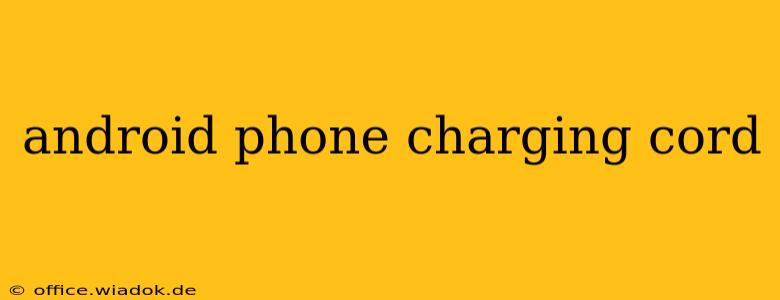Choosing the right Android phone charging cord might seem simple, but with so many options available, it's easy to get overwhelmed. This comprehensive guide will delve into the crucial factors to consider when selecting a charging cable for your Android device, ensuring you get the best possible performance and longevity.
Understanding Android Charging Standards
Before diving into specific cable features, it's important to grasp the different charging standards used by Android devices. While USB-C has become the dominant standard, you might still encounter Micro-USB on older devices. Understanding this distinction is crucial for compatibility.
-
USB-C: This is the most prevalent standard for modern Android phones. It offers faster charging speeds and data transfer rates compared to its predecessor. Look for cables explicitly labeled as supporting USB-C.
-
Micro-USB: Older Android phones utilize this connector type. While still functional, charging speeds are slower than USB-C. Ensure you purchase a Micro-USB cable if your device uses this connector.
Key Features to Consider When Buying an Android Charging Cord
Selecting the right cable involves more than just matching the connector type. Several factors significantly impact charging speed, durability, and overall user experience.
1. Charging Speed & Power Delivery (PD)
The charging speed largely depends on the cable's capacity to handle power delivery (PD). Look for cables that support fast charging technologies like Quick Charge (Qualcomm), Adaptive Fast Charging (Samsung), or USB Power Delivery (USB-PD). These technologies significantly reduce charging time compared to standard charging. Higher wattage cables generally mean faster charging speeds.
2. Cable Length & Durability
The cable's length is a matter of personal preference, but consider your usage scenario. A longer cable offers more flexibility, while a shorter one is more portable. Durability is paramount. Look for cables with reinforced connectors and braided nylon or other robust materials to withstand daily wear and tear. Avoid flimsy cables prone to fraying and breaking.
3. Material & Construction
The material of the cable directly impacts its durability and charging efficiency. Braided nylon cables are generally more durable than standard PVC cables. A high-quality cable will have sturdy connectors that don't wobble or easily detach. Check for reinforced stress points where the cable meets the connector—this is often a weak point.
4. Data Transfer Capabilities
While primarily used for charging, many cables also support data transfer. If you intend to use the cable to connect your phone to a computer for file transfers, ensure it's a data transfer-capable cable. This feature is often implicitly included with USB-C cables, but it's worth checking the specifications.
5. Brand Reputation & Warranty
Investing in a reputable brand often translates to higher quality and longer lifespan. Check for manufacturer warranties; a warranty demonstrates the company's confidence in its product's reliability.
Troubleshooting Common Charging Issues
Even with a high-quality cable, charging problems can occur. Here are some common issues and troubleshooting steps:
- Slow charging: Check the cable and wall adapter for compatibility with fast charging. Ensure the cable isn't damaged.
- Intermittent charging: Try a different cable and wall adapter. Inspect the charging port on your phone for any debris.
- No charging at all: Check the wall outlet and the adapter. Try a different cable and adapter to rule out cable malfunction.
Conclusion
Choosing the right Android phone charging cord requires considering several factors beyond just the connector type. By understanding charging standards, prioritizing durability and charging speed, and choosing a reputable brand, you can ensure a reliable and efficient charging experience for your Android device. Remember to always check the specifications and look for features that cater to your specific needs and usage patterns. This investment in a high-quality cable will save you time, frustration, and ultimately, money in the long run.

